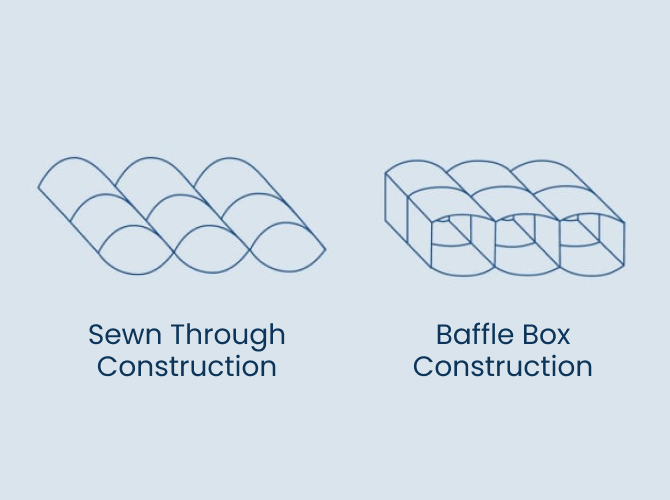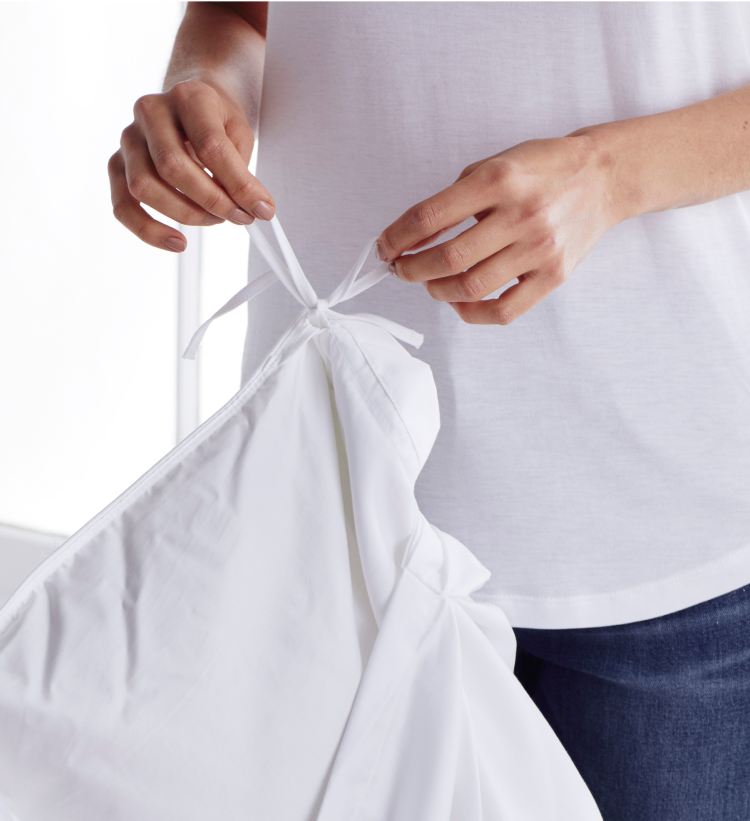
All About Comforter Construction
All comforters are constructed from the same two basic parts: an outer shell and a lofty down or down alternative fill. The outer shell forms an envelope around the fill, closed with stitching around all four sides. Additional stitches keep the fill evenly distributed by tacking it down or trapping it in smaller chambers. Each construction technique offers its own benefits, from warmth to styling. Explore this guide to learn all about comforter construction and stitching types, then explore our Comforter Buying Guide to see what else goes into crafting the best comforter.
How Are Comforters Constructed?
The Company Store uses 100% cotton shells and either ethically sourced, Responsible Down Standard (RDS) certified down or synthetic, down-free fill. Both down and down alternative comforters are finished with stitching that keeps the fill from shifting. The most common comforter stitching techniques are sewn-through box and baffle box, but ring- and channel-stitched are other stylish options.
What’s the difference between these construction techniques, and how do you choose from baffle box, sewn-through box, and other comforter stitch styles? The “right” stitching technique is often a matter of preference. These definitions can help you choose your ideal comforter construction method.
What is Box Stitching?
Comforters often feature classic box stitching to prevent the fill from shifting and to evenly distribute its warmth. This style creates square- or diamond-shaped chambers that hold the down or down alternative fill. The box sizes usually correlate to warmth level—the bigger the square, the loftier and warmer the comforter; smaller squares often provide a light to medium level of warmth.


Sewn-through box construction means the shell’s top and bottom fabric layers are stitched together. This stitching forms pockets of fill for a puffy and pillow-like appearance.
Baffle box construction creates pockets of fill using fabric stitched like walls between the “floor” and “ceiling” of the comforter shell. The separation is inside the comforter, rather than stitched through the layers. This construction offers a flatter surface and allows the fill to loft as fully at the edges of its chamber as in the center, reducing cold spots and still preventing the fill from shifting.
What is a Ring Stitch Comforter?
Ring stitching is a construction technique that uses subtle circle-shaped tacking at regular intervals over the entire comforter. Also called “button-tufted,” this construction technique tacks down the fill with style, creating a uniform, decorative surface.


Other Comforter Finishing Techniques
While these are our favorite stitch techniques, they’re not the only options. If you prefer a box-free look, try a baffled or sewn-through comforter with long channel stitching instead of quilted diamonds or squares. Comforters without top-stitching offer a streamlined look, but the fill inside may shift and bunch over time, which shortens the lifespan of your comforter.
Looking for a top layer with a smooth surface, without visible stitching? Tuck your comforter or duvet insert inside a duvet cover, secure it with the durable corner ties, and you get the same warmth and quality construction, with no stitching in sight. Not only does this protect your comforter, but you have the added bonus of being able to swap the duvet cover whenever you crave fresh decor.
Comforters are a favorite bedding layer, and you can find options for any season. We offer limited-edition prints, vibrant solid colors, and classic patterns to suit every taste. Looking for more bedding tips and tricks? We provide plenty of ideas on our Tips & Ideas page.
